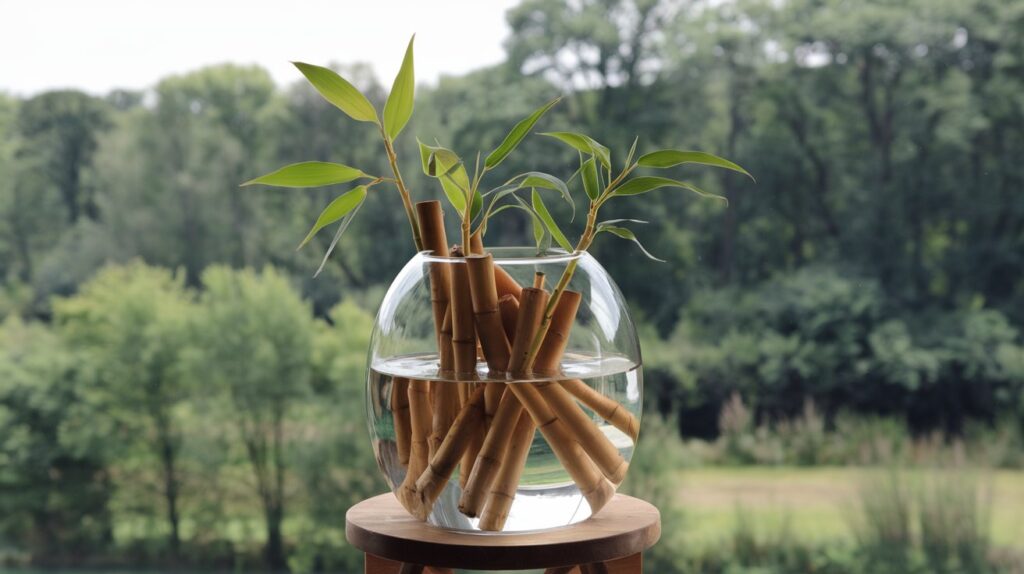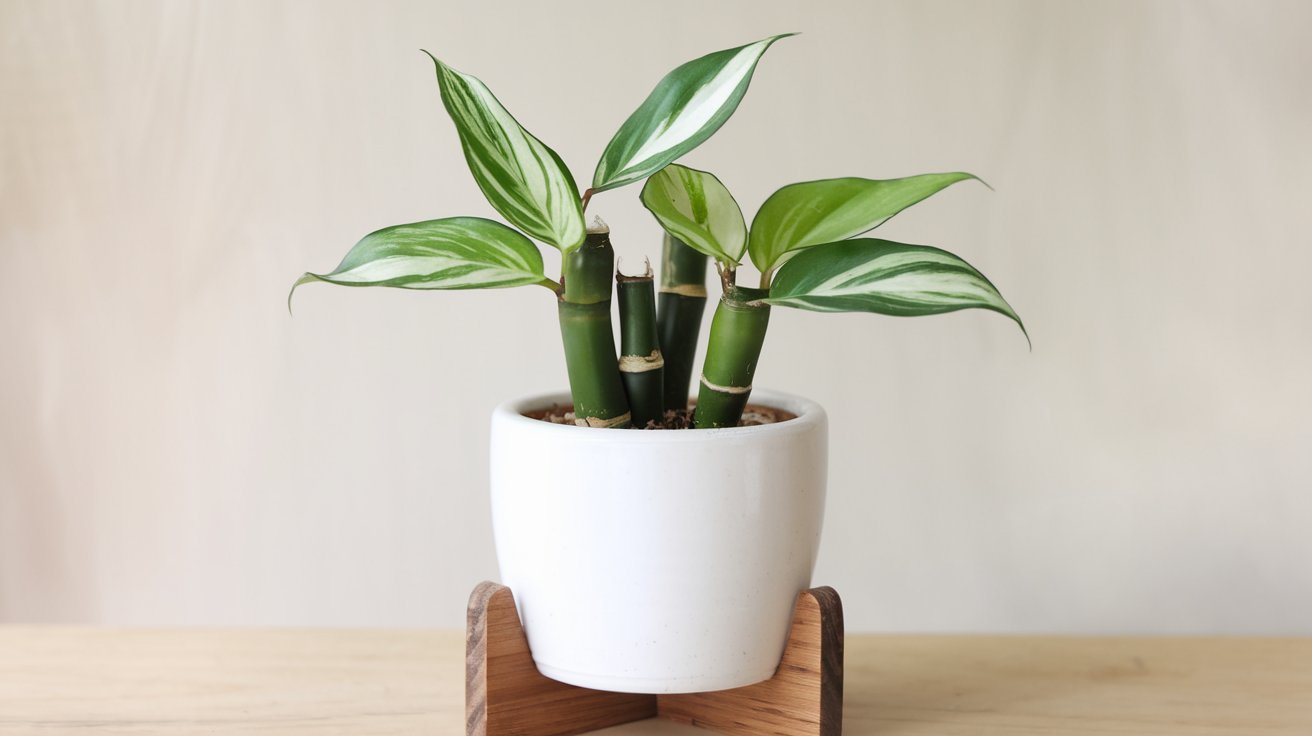Table of Contents
Introduction
Lucky bamboo (Dracaena sanderiana) has captivated plant enthusiasts worldwide, not just for its elegant appearance but also for its cultural significance in bringing good fortune. Despite its name, this resilient plant isn’t actually bamboo at all – it’s a member of the Dracaena family. In this comprehensive guide, we’ll explore everything you need to know about growing and caring for lucky bamboo, ensuring your plant thrives while potentially bringing prosperity to your space. Whether you’re a seasoned plant parent or just beginning your journey with lucky bamboo, this guide will provide you with all the essential information needed for success.
The History and Significance of Lucky Bamboo
Ancient Origins
Lucky bamboo has been cultivated in China for thousands of years, where it’s known as “Fu Gwey Zhu.” The plant’s straight stalks represent strength, while its lush green leaves symbolize vitality and growth. Historical records show that lucky bamboo was first cultivated during the Han Dynasty (202 BCE – 220 CE), where it was primarily grown in the Guangdong Province. Its popularity quickly spread throughout Southeast Asia, becoming an integral part of various cultural practices and traditions.
Cultural Impact Across Asia
Beyond China, lucky bamboo has significant cultural importance in:
- Taiwan: Known as “開運竹” (kāiyùn zhú), meaning “opening luck bamboo“
- Japan: Called “幸運の竹” (kōun no take), often given as gifts during New Year
- Vietnam: “Phát tài,” representing financial growth and success
Feng Shui Significance
In feng shui practice, lucky bamboo is believed to attract positive energy or “chi.” Different numbers of stalks carry unique meanings:
- 2 stalks: love and marriage
- 3 stalks: happiness, wealth, and longevity
- 5 stalks: balance in all areas of life
- 7 stalks: good health
- 8 stalks: growth and prosperity
- 9 stalks: great fortune
- 21 stalks: powerful all-encompassing blessing
The arrangement and placement of lucky bamboo in your space can significantly impact its feng shui benefits:
- East location: Promotes family harmony
- Southeast area: Increases wealth and abundance
- North zone: Enhances career opportunities
Botanical Classification and Characteristics
Scientific Background
- Family: Asparagaceae
- Subfamily: Nolinoideae
- Genus: Dracaena
- Species: D. sanderiana
Physical Characteristics
Lucky bamboo exhibits several distinct features:
- Stems: Typically green, can turn yellow or red with adequate sunlight
- Leaves: Narrow, lanceolate shape, growing directly from the stem
- Height: Can grow up to 3 feet tall in optimal conditions
- Growth rate: Moderate, adding new leaves every 4-6 weeks
Natural Habitat
In its native environment, lucky bamboo:
- Grows under the canopy of larger trees
- Thrives in humid, tropical conditions
- Often found near water sources
- Adapts to varying light conditions
Essential Growing Conditions
Light Requirements
Lucky bamboo thrives in bright, indirect light. Direct sunlight can scorch the leaves, while too little light can stunt growth.
Optimal lighting conditions include:
- North or east-facing windows
- Filtered light through sheer curtains
- 3-4 feet away from south-facing windows
Light intensity guide:
- Too much light: Leaves turn yellow or pale
- Too little light: Growth slows, leaves darken
- Perfect light: Vibrant green leaves, steady growth
Temperature and Humidity
- Optimal temperature range: 65-95°F (18-35°C)
- Prefers humidity levels above 50%
- Avoid cold drafts and sudden temperature changes
Temperature management tips:
- Use a thermometer to monitor conditions
- Move plants away from AC vents
- Consider a humidity tray in dry environments
Signs of temperature stress:
- Leaf curling: Too hot
- Yellowing leaves: Too cold
- Brown leaf tips: Low humidity
Water Quality and Care

Water type comparison:
- Distilled water: Best option, no minerals
- Filtered water: Good choice, minimal chemicals
- Tap water: Use only if left out for 24 hours
- Rainwater: Excellent natural option
Water care routine:
- Change water every 1-2 weeks
- Maintain water level at 1-3 inches for stalks in water
- For soil-grown plants, keep soil consistently moist but not waterlogged
Water quality troubleshooting:
- Algae growth: Change water more frequently
- Cloudy water: Clean container and roots
- Odorous water: Immediate water change needed
Growing Methods
Water Cultivation
Growing lucky bamboo in water is the most popular method:
- Choose a clear or decorative container
- Add clean pebbles for stability
- Fill with appropriate water
- Place stalks and adjust pebbles
Advanced water cultivation tips:
- Use colored glass beads for decorative effect
- Try activated charcoal to prevent algae growth
- Experiment with different container shapes
Water level maintenance:
- Mark ideal water level on container
- Monitor evaporation rates
- Adjust water level seasonally
Soil Growing
Some prefer growing lucky bamboo in soil:
- Use well-draining potting mix
- Ensure pot has drainage holes
- Keep soil consistently moist
- Consider adding slow-release fertilizer
Soil mix recipe:
- 40% potting soil
- 30% perlite
- 20% orchid bark
- 10% activated charcoal
Benefits of soil growing:
- More stable growing environment
- Enhanced nutrient availability
- Potential for larger growth
- Reduced maintenance frequency
Fertilization and Nutrition
Water-Grown Plants
Fertilization schedule:
- Monthly during growing season
- Bi-monthly during winter
- Use liquid fertilizer at 1/10 strength
Nutrient deficiency signs:
- Pale leaves: Nitrogen deficiency
- Purple stems: Phosphorus deficiency
- Yellow leaf edges: Potassium deficiency
Soil-Grown Plants
Fertilization guidelines:
- Use balanced, water-soluble fertilizer
- Apply every 2-3 months
- Reduce feeding in winter
Organic fertilizer options:
- Diluted seaweed extract
- Fish emulsion (use cautiously)
- Compost tea
Common Problems and Solutions
Yellowing Leaves
Causes:
- Chlorine in tap water
- Too much direct sunlight
- Nutrient deficiencies
- Over-fertilization
Solutions:
- Switch to filtered water
- Move to indirect light
- Adjust fertilization routine
- Trim affected leaves
Prevention tips:
- Regular water changes
- Consistent care routine
- Proper light management
Root Rot
Causes:
- Stagnant water
- Poor water quality
- Overcrowding
Symptoms:
- Mushy, brown roots
- Foul odor
- Yellowing leaves
- Stunted growth
Treatment:
- Remove affected roots
- Change water completely
- Clean container thoroughly
- Consider hydrogen peroxide treatment
Pest Management
Common pests include:
- Mealybugs
- Spider mites
- Scale insects
Identification guide:
- Mealybugs: White, cottony clusters
- Spider mites: Fine webbing, stippled leaves
- Scale: Brown bumps on stems
Control methods:
- Isolate affected plants
- Wipe leaves with diluted neem oil
- Use insecticidal soap if necessary
- Prune heavily infested areas
Natural pest deterrents:
- Cinnamon powder
- Garlic spray
- Beneficial insects
Propagation Techniques
Stem Cuttings
Detailed steps:
- Select healthy stems
- Cut into 6-inch sections
- Remove lower leaves
- Apply rooting hormone (optional)
- Place in fresh water
- Wait for roots to develop (2-3 weeks)
Troubleshooting propagation:
- No root growth: Check water quality
- Rotting stems: Reduce water level
- Slow growth: Increase temperature
Success indicators:
- White root nubs appearing
- New leaf growth
- Bright green stem color
Division
Step-by-step guide:
- Separate stalks with roots
- Untangle roots gently
- Trim any damaged roots
- Replant in fresh medium
- Maintain optimal growing conditions
Post-division care:
- Reduce light temporarily
- Maintain higher humidity
- Hold off on fertilization
Design and Decoration
Creative Display Ideas
Popular arrangements:
- Glass vases with colored pebbles
- Bamboo towers with multiple levels
- Braided or spiral arrangements
- Terrarium setups

Advanced design techniques:
- Layer different colored pebbles
- Use LED lighting for enhancement
- Create mini water gardens
Complementary Plants
Pair lucky bamboo with:
- Peace lilies
- Chinese evergreens
- Pothos
- Spider plants
Design principles:
- Balance heights and textures
- Consider growth rates
- Match water or soil preferences
Seasonal Care Guide
Spring Care (March-May)
- Increase watering frequency
- Begin fertilization schedule
- Check for new growth
- Prune any winter damage
Summer Care (June-August)
- Monitor water temperature
- Increase humidity if needed
- Protect from AC drafts
- Watch for faster growth
Fall Care (September-November)
- Reduce fertilization
- Clean leaves monthly
- Check heating vents location
- Prepare for lower light conditions
Winter Care (December-February)
- Reduce watering slightly
- Protect from cold drafts
- Maintain consistent temperature
- Hold off on propagation
Frequently Asked Questions
- Q: How long does lucky bamboo live? A: With proper care, lucky bamboo can live for several years, typically 1-5 years in water and up to 10 years in soil.
- Q: Can lucky bamboo survive in low light? A: While it can tolerate low light conditions, lucky bamboo grows best in bright, indirect light for optimal health and growth.
- Q: Why are the leaves turning yellow? A: Yellowing leaves often indicate water problems (chlorine/fluoride), too much direct sunlight, or nutrient deficiencies.
- Q: How often should I fertilize lucky bamboo? A: For water-grown plants, add a drop of liquid fertilizer every 2-3 months. Soil-grown plants can be fertilized monthly during growing season.
- Q: Can I trim my lucky bamboo? A: Yes, trimming promotes bushier growth. Cut stems just above a node using clean, sharp scissors.
Lucky Bamboo as Gifts
Gift-Giving Etiquette
Cultural considerations:
- Considered auspicious in many cultures
- Often given for:
- House warmings
- Business openings
- New year celebrations
- Weddings
Symbolic meanings:
- Upright stalks: Growth and progress
- Braided stalks: Harmony and unity
- Curly stalks: Creativity and uniqueness
Presentation Ideas
- Decorative pots
- Custom arrangements
- Care instruction cards
- Feng shui placement guide
Gift wrapping tips:
- Use red or gold paper for luck
- Include a care guide
- Add personal message
- Consider recipient’s decor
Conclusion
Lucky bamboo is more than just a decorative plant; it’s a symbol of good fortune that, with proper care, can bring both aesthetic beauty and positive energy to your space. Whether you’re growing it in water or soil, following these guidelines will help ensure your lucky bamboo thrives for years to come. Remember that patience and consistency are key – with the right care, your lucky bamboo will not only survive but flourish, potentially bringing its promised luck and prosperity to your home or office.

